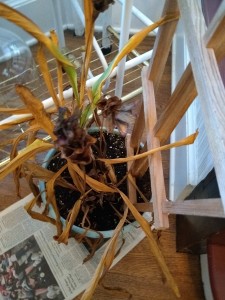 Last week I wore myself out getting all the tender potted plants into the house before the arctic weather set in. I have spent the past week sweeping up dead leaves as many of those same plants went to pieces over the shock of moving from the bright outdoor light into the best-that-I-can-do light indoors. Of course they dominate the window ledges and bright spots and most have some supplemental light, but all of that heroic effort still does not add up to the sunshine in which they all basked until last week. The shock is normal and most will recover nicely, but I still apologize to them every day as I apply the watering can.
Last week I wore myself out getting all the tender potted plants into the house before the arctic weather set in. I have spent the past week sweeping up dead leaves as many of those same plants went to pieces over the shock of moving from the bright outdoor light into the best-that-I-can-do light indoors. Of course they dominate the window ledges and bright spots and most have some supplemental light, but all of that heroic effort still does not add up to the sunshine in which they all basked until last week. The shock is normal and most will recover nicely, but I still apologize to them every day as I apply the watering can.
The plant that appears to be suffering the most dramatically is the ornamental ginger or Hedychium. Its large, erect leaves were mostly green eight days ago. Now they are ninety percent brown and I am properly horrified.
Ornamental ginger or ginger lily is a genus that contains about fifty species, native to India, the Himalayas and China, according to English plantsmen, Roger Phillips and Martyn Rix. It is part of the large Zingerberaceae or ginger family, which also includes culinary ginger. Some of the commercially available plants are varieties of Hedychium coronaria, also known as the “butterfly ginger plant”, for its white, butterfly-like individual flowers. Butterfly ginger also has a fragrance said to resemble that of honeysuckle. Many other available Hedychium varieties are hybrids, notable for the extremely fragrant, eight to twelve-inch flowerheads that sit atop the tall stalks. Blooming in late summer, our particular specimen had dark rose-colored flowers, but other varieties may feature blooms in all colors except true blue. I think the yellow and peach varieties, like ‘Elizabeth’, are especially pretty.
The ginger lily first arrived in Europe in 1819 and caught on. Rich Victorians used the large, decorative plants in their new conservatories. Eventually a combination of factors—the cost of heating conservatories, the tenderness of plants grown outdoors, the fickle plant fashion cycle—conspired to diminish the popularity of the ginger lily.
Most ornamental plants are either wildly popular, moderately popular, completely out of fashion, or about to be rediscovered with great fanfare. According to the always reliable and authoritative Tony Avent of Plant Delights Nursery, ginger lily was rediscovered in 1965, by Tony Schilling, a botanist working for the Royal Horticultural Society’s Kew Gardens. Since then, hybridizers have been hard at work, and now the genus is wildly popular, with over 100 cultivated varieties or cultivars available to the public.
In many places—including cold winter ones–tropical plants, with their big, bold leaves and showy flowers are experiencing a real renaissance. Wealthy people in northern latitudes either overwinter ginger lilies under glass or treat them as annuals, along with tropical fellow travelers including elephant ears, banana trees and cannas. Non-wealthy people like me heft up the large containers and lug them indoors, or lift the rhizomes and store them, cool and dry, in containers full of sphagnum moss.
When I look at the browned leaves of my ginger lily, I feel a gnawing sense of failure. However, the bout of psychological self-flagellation that I am about to inflict on myself may be premature. Ginger lilies are rhizomatous perennials. In their native habitats, they normally experience a dormancy period in winter. Of course, containerized plants that are kept at 65 degrees Fahrenheit or above are supposed to be evergreen. I am hoping that my plant has either entered dormancy, or will sprout some new green leaves when it gets over the agony of readjustment to indoor conditions. For the moment, I will trim back the withered leaves, water appropriately and bide my time. Sometimes a little inertia on the gardener’s part does wonders for plants.
If you have a yen for a ginger lily and a nice, warm, well-lit place to raise it, check out Logees at 141 North Street, Danielson, CT 06239; (860) 774-8038. www.logees.com. Free print catalog.
